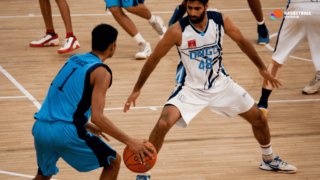
When it comes to maximizing performance and staying injury-free, the devil is in the details—especially when it comes to the shoes on your feet. The question we often hear is, “Are basketball shoes good for lifting?” As both an enthusiast in the gym and on the court, you’ve come to the right place to explore the intersection of these two activities. Dive in as we examine the benefits and drawbacks of basketball shoes in the weight room, and reveal whether or not your trusty kicks are standing up to the task. Strap in and prepare for an exhilarating investigation into the fascinating world of footwear functionality!
Are Basketball Shoes Good for Lifting?
While basketball shoes provide excellent support and stability for lateral movements, they may not be the best option for lifting. Proper lifting shoes should have flat, firm soles for optimal stability and force transfer during exercises like squats and deadlifts. Basketball shoes often have cushioned soles, which may diminish stability and cause uneven weight distribution. It’s recommended to use dedicated lifting shoes or minimalist, flat-soled shoes for better performance and safety during weightlifting.
Understanding the Anatomy of Basketball Shoes
To explore the suitability of basketball shoes for lifting, let’s first delve into their design and purpose. Basketball shoes cater to the unique demands of the sport, which include ample support and stability for lateral movements, quick starts and stops, and jumps. With this in mind, let’s look at the key features of basketball shoes.
High or Mid-Top Design
Basketball shoes typically have a high or mid-top design that offers more ankle support and stability for the fast-paced movements and constant shifts in direction associated with the sport. This design helps prevent ankle injuries and adds a sense of security while making those quick cuts on the court.
Cushioned Soles
Basketball shoes frequently feature cushioned soles that serve as shock absorbers when players jump and land. This helps to reduce the impact and stress on the joints and muscles, protecting players from injury and improving comfort throughout the game.
Traction Outsoles
Traction is crucial in basketball. The outsoles of basketball shoes are designed with multidirectional patterns and grippy materials, enabling players to move swiftly and confidently without the fear of slipping and losing control.
The Ideal Shoe for Weightlifting
Before we determine whether basketball shoes can double as efficient lifting shoes, let’s consider what the perfect weightlifting shoe entails. Key features of lifting shoes include stability, flexibility, a snug fit, and a sturdy heel platform.
Stable and Flat Soles
Good weightlifting shoes have stable, non-compressed soles, enabling a lifter to maintain proper posture and balance while performing exercises like squats, deadlifts, and Olympic lifts. A flat sole ensures even weight distribution, providing a stable surface for lifters to push against and generate maximum force during the execution of the lifts.
Structure and Fit
A tight and secure fit is essential in lifting shoes because any movement or slippage inside the shoe can lead to reduced performance, instability, or injury. Lifting shoes should have either laces, straps, or a combination of both to provide a snug fit that keeps the foot in place during exercises.
Heel Height and Structure
Weightlifting shoes often have a raised, solid heel that assists in maintaining an upright torso during squats and Olympic lifts. This design helps to compensate for limited ankle mobility and fosters proper weightlifting mechanics. However, heel height may vary based on the specific requirements and preferences of the individual lifter.
Comparing Basketball Shoes and Lifting Shoes
With a basic understanding of the features that define basketball shoes and lifting shoes, we can now compare their performance characteristics and determine whether basketball shoes can meet the demands of a weightlifting workout.
Ankle Support and Mobility
While the ankle support provided by basketball shoes may seem advantageous for weightlifting, it can sometimes hinder ankle mobility during certain lifts, such as deep squats. Weightlifting shoes with a lower cut provide the necessary ankle flexibility for optimal performance.
Sole Composition and Function
The cushioned soles of basketball shoes, designed for shock absorption during jumps, are not ideal for weightlifting. The squishy soles can interfere with stability during heavy lifts, as they provide an uneven platform for weight distribution. This may result in poor lifting form and even injury. In contrast, lifting shoes are built with firm, flat soles that provide the necessary surface for proper force transfer and stability during weightlifting moves.
Heel Height Considerations
Basketball shoes usually feature a flat heel, which can limit the effectiveness of certain lifts, particularly for individuals with poor ankle mobility. Weightlifting shoes come with a raised, solid heel to improve mechanics during squats and other barbell lifts. However, it is important to note that not all exercises require a raised heel; powerlifters and other strength athletes may prefer a flatter sole to perform deadlifts or low-bar squats.
The Verdict: Are Basketball Shoes Good for Lifting?
When it comes to weightlifting, basketball shoes fail to provide the necessary support, stability, and appropriate sole composition required for optimal performance. While basketball shoes excel on the court, they fall short in the realm of weightlifting due to their cushioned soles, high-top design, and flat heels.
Possible Alternatives to Basketball Shoes for Lifting
If you’re searching for more suitable shoes for weightlifting, here are some alternatives to consider:
Dedicated Weightlifting Shoes
A pair of specialized weightlifting shoes will provide you the necessary support, stability, and sole composition. These shoes are specially designed for the movements and mechanics of lifting, ensuring the enhancement of your performance while reducing the risk of injury.
Minimalist or Barefoot Shoes
If you’re not keen to splurge on a separate pair of weightlifting shoes, minimalist or barefoot shoes can be another option for the gym. These shoes offer less cushioning and a more natural, close-to-the-ground feel, providing a firmer base for weightlifting. However, they may not offer the same level of support and elevated heel found in dedicated lifting shoes.
Flat Athletic Shoes
A third option to consider is a pair of flat-soled athletic shoes, such as CrossFit shoes or classic Converse Chuck Taylors. Although perhaps not as specialized as weightlifting shoes, these options offer a flat, firm sole that is more suitable for weightlifting compared to the cushioned soles of basketball shoes.
Making the Most of Your Weightlifting Experience
Selecting the right footwear is crucial for both safety and performance while weightlifting. Though basketball shoes may be highly effective on the court, they fail to offer the necessary stability and support required for lifting. Make your lifting experience even more enjoyable, safe, and efficient by investing in dedicated weightlifting shoes, minimalist shoes, or flat athletic shoes. By doing so, you’ll be one step closer to unlocking your weightlifting potential and crushing those personal records in the gym.
Finding the Perfect Balance: Can You Modify Basketball Shoes for Lifting?
As we’ve established that basketball shoes are not the ideal choice for lifting due to their design and functionality, some might wonder if it’s possible to modify basketball shoes to make them more suitable for lifting. While it’s not recommended to make drastic changes to your shoes, there are a few minor adjustments you can try to enhance their weightlifting performance:
Experiment with Loose Lacing
One issue with basketball shoes while lifting is their constraining high or mid-top design, which can restrict ankle mobility. Try loosening the laces around the ankle area to allow for more flexibility. Remember to retighten the laces around the midfoot and forefoot sections for optimal security and support during your lifts.
Try Using a Flat Insole
To minimize the cushioning in the basketball shoe, considering replacing the original insole with a thinner, flatter one. This may provide a more stable surface for lifting; however, it’s important to note that this makeshift solution won’t completely transform the shoe into an ideal lifting option. It is simply a temporary workaround if you’re hesitant to invest in dedicated lifting shoes.
How to Choose the Right Weightlifting Shoes
If you decide to invest in a dedicated weightlifting shoe, making the right choice is essential in optimizing your lifting experience. Here are a few points to consider when selecting your lifting shoes:
Research Shoe Brands and Models
Multiple brands offer weightlifting shoes, with top companies like Nike, Adidas, and Reebok regularly launching new models. Research which brands and models align with your preferences and needs, and be sure to read user reviews for additional insight.
Choose the Right Heel Height
Make sure to select a weightlifting shoe with a heel height that matches your desired level of comfort and mobility. Heel height varies depending on one’s personal requirements and preferences, so experiment with different heel heights to find the one that works best for you.
Test for Optimal Fit and Comfort
Before making a purchase, try on multiple sizes and models to determine the best fit for your feet. Comfort should not be compromised, as discomfort can lead to reduced focus on proper lifting form and increase the risk of injury.
Invest in Quality and Durability
Lastly, it’s crucial to invest in a shoe with quality materials and construction that will withstand the rigors of weightlifting. Good lifting shoes are an investment in your health and fitness, so make sure to choose a durable and high-quality option that will last you for years to come.
Maintaining Lifting Performance with the Right Footwear
As we’ve made clear, basketball shoes are not the best choice for lifting. They lack the essential features required for proper weightlifting, such as stable flat soles and ample ankle mobility, which can lead to instability, poor lifting form, and even injury. By investing in dedicated weightlifting shoes, minimalist shoes, or flat athletic shoes, you can significantly improve your lifting performance and avoid potential issues caused by using inappropriate footwear. The importance of having the right shoe for each sport or physical activity cannot be overstated, so always consider the specific demands of an activity when choosing your shoes to maximize your performance and minimize the risk of injury.
Frequently Asked Questions
As the topic of mixing basketball shoes and weightlifting has many facets, we’ve gathered a list of frequently asked questions to help address any lingering concerns or queries. Read on to explore the most common questions and their answers related to basketball shoes and lifting.
1. Why do basketball shoes have cushioning while lifting shoes have flat, firm soles?
Basketball shoes have cushioning to provide shock absorption for jumping and landing, reducing stress on the joints and muscles. In contrast, lifting shoes have flat, firm soles to provide a stable surface for weight distribution, enabling better force transfer and balance while performing weightlifting exercises.
2. Can I use running shoes for lifting?
Running shoes, like basketball shoes, have cushioned soles that don’t offer the stability and force transfer needed for lifting. They are designed for forward motion and shock absorption, making them unsuitable for weightlifting. It’s better to use dedicated lifting shoes or flat athletic shoes for lifting.
3. Is it okay to lift barefoot?
While lifting barefoot allows for better proprioception and a stable, flat surface, it also offers less stability, support, and protection for the feet. Some gyms may have rules against barefoot lifting, so it’s better to opt for minimalist or barefoot-style shoes that mimic the natural foot structure and provide some protection.
4. Are all weightlifting shoes the same?
No, weightlifting shoes can vary in terms of heel height, materials, overall design, and support. It’s crucial to choose a shoe that caters to your individual needs and preferences for optimum comfort and performance.
5. Can I use CrossFit shoes for lifting?
CrossFit shoes that offer flat, non-compressed soles can be suitable for lifting. However, specialized weightlifting shoes provide extra benefits such as an elevated heel and more rigid construction, which can enhance your lifting experience.
6. How long do weightlifting shoes usually last?
Weightlifting shoes are designed to be durable and can typically last 2-3 years, depending on usage and quality. Regularly inspect your shoes for signs of wear and replace them when necessary to ensure optimal performance and safety.
7. Are basketball shoes suitable for other sports or gym activities?
While basketball shoes may not be ideal for weightlifting or running, they are suitable for sports featuring similar movement patterns, such as volleyball or indoor court sports. However, it’s always best to use specialized shoes designed for specific sports or activities for the best performance and injury prevention.
8. What are some popular weightlifting shoe brands?
Some popular weightlifting shoe brands include Adidas, Nike, Reebok, and Inov-8. These brands offer a variety of models to cater to different preferences, needs, and budgets.
9. When should I replace my weightlifting shoes?
Replace your weightlifting shoes when you notice a loss of support, stability, or signs of wear that could compromise safety or performance. Also, consider replacing them if you experience discomfort or a change in your lifting mechanics.
10. Can weightlifting shoes improve my lifting performance?
Yes, weightlifting shoes can improve your lifting performance by providing a stable base, proper force transfer, and enhanced mobility. These factors contribute to better posture and balance, enabling you to execute lifts efficiently and safely.
11. Are weightlifting shoes necessary for all types of weight training?
Weightlifting shoes are particularly beneficial for exercises that demand stability and force transfer, such as squats, deadlifts, and Olympic lifts. While they may not be essential for all types of weight training, they offer advantages that can optimize your lifting experience.
12. How do I care for my weightlifting shoes?
Keep your weightlifting shoes clean by wiping off dirt and sweat with a damp cloth. Avoid machine washing, as it can damage the materials. If your shoes get wet, stuff them with paper to absorb moisture and maintain their shape. Store your shoes in a cool, dry place to prevent odor and material degradation.
13. Can I use weightlifting shoes for other gym activities?
Weightlifting shoes are specifically designed for lifting and may not be the best option for other activities such as cardio workouts or agility exercises. Consider using cross-training or specialized shoes for those activities to ensure optimal performance and comfort.
Featured Posts
- No pillar pages found.





